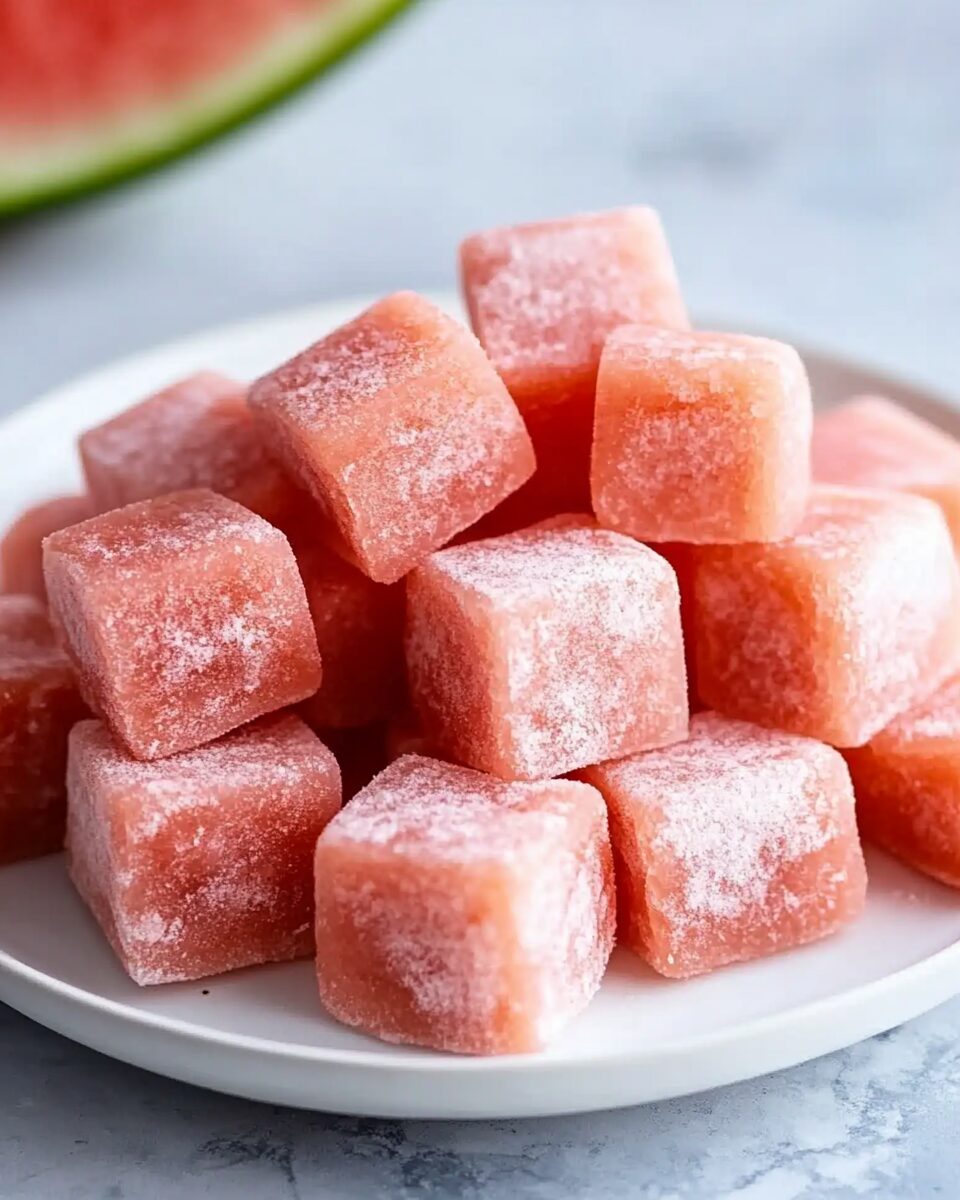This Watermelon Mochi is a soft, chewy, and naturally sweet treat made with real watermelon juice. It’s a gluten-free, vegan, dye-free version of the classic Japanese mochi, using glutinous rice flour and tapioca starch for that signature bouncy texture. Lightly sweetened with maple sugar and shaped into adorable bite-sized cubes, it’s the perfect refreshing summer dessert—free from refined sugar, corn, and dairy.
Full Recipe:
Ingredients
-
1 cup glutinous rice flour (plus more for dusting)
-
¼ cup maple sugar
-
⅓ cup tapioca starch
-
¾ cup fresh watermelon juice (strained)
-
2 tablespoons avocado oil (divided)
Directions
-
Make the Juice: Blend fresh watermelon until smooth. Strain through a fine mesh sieve and measure out ¾ cup of juice.
-
Mix the Dough: In a bowl, whisk glutinous rice flour, maple sugar, and tapioca starch. Add watermelon juice and 1 tbsp avocado oil. Whisk until smooth.
-
Cook the Dough: Heat a non-stick skillet over low-medium heat. Add 1 tbsp avocado oil, then pour in the mochi mixture. Stir constantly for 3–4 minutes until it thickens into a sticky dough and darkens slightly.
-
Shape & Chill: Using lightly oiled hands, form the dough into a ball. Transfer it to parchment paper and shape it into a square. Place into a 15cm x 15cm container lined with parchment. Cover and chill for 1–2 hours.
-
Dust & Cut: Once firm, dust both sides with glutinous rice flour. Use an oiled knife to cut into cubes (about 20). Dust all sides to prevent sticking.
-
Serve Immediately. Enjoy the soft, chewy bites fresh, or refrigerate for up to 2 days in an airtight container.
Nutrients (Per piece, approx. 20 pieces per batch)
-
Calories: ~45 kcal
-
Carbohydrates: ~10 g
-
Fat: ~1 g
-
Sugar: ~2 g
-
Protein: ~0.5 g
-
Fiber: <1 g
-
Sodium: ~5 mg
-
Cholesterol: 0 mg
The Beauty of Mochi: A Bite-Sized Comfort Food
Mochi is a traditional Japanese sweet made from glutinous rice that’s been pounded into a smooth, elastic dough. Known for its chewy, satisfying texture, mochi is often filled with sweet bean paste or flavored with matcha, fruit, or other ingredients. It’s a food of celebration and comfort—simple, yet deeply nostalgic.
This watermelon version reimagines mochi as a warm-weather dessert, incorporating the cool sweetness of real fruit. It’s a softer, less structured take that skips the filling and instead allows the flavor of the dough itself to shine. Each piece is tender and chewy, melting slightly on the tongue before bouncing back with every bite.
Fresh Watermelon for Natural Flavor and Color
Watermelon is the defining ingredient in this recipe, and it brings far more than just a fruity taste. When fresh watermelon is blended and strained, it creates a vibrant juice that adds both natural sweetness and a gorgeous pink hue to the mochi dough. This makes the dessert dye-free and visually stunning, especially when cut into neat cubes or small rounds.
The juice also adds a delicate aroma that lingers pleasantly in each bite. It’s a flavor that feels cooling and familiar, a gentle nod to everything we love about summertime. Since no refined sugars or flavorings are needed, the watermelon becomes the star, delivering pure, unfiltered sweetness in a refreshingly light way.
A Dessert for Every Dietary Lifestyle
One of the highlights of Watermelon Mochi is how inclusive it is. The recipe is naturally gluten-free, thanks to glutinous rice flour and tapioca starch—two ingredients known for their elasticity and soft chewiness. Despite the name, glutinous rice flour contains no gluten; the term refers to its sticky texture when cooked, which gives mochi its signature bounce.
This dessert is also completely dairy-free and egg-free, making it suitable for vegans and those with lactose intolerance. Instead of butter or dairy, avocado oil provides a touch of richness and helps keep the dough pliable. And in place of refined sugar, a bit of maple sugar sweetens the mochi while keeping it low on the glycemic index. This combination makes it a dessert you can enjoy often without compromising your health goals or dietary needs.
Chewy, Soft, and Just the Right Amount of Sweet
Texture is everything when it comes to mochi, and this recipe nails it. The combination of glutinous rice flour and tapioca starch results in a dough that’s soft, slightly elastic, and satisfying to bite into. After a brief cooking process, the dough becomes pliable and smooth, perfect for shaping and cutting once it has cooled.
Each piece of watermelon mochi has a tender chew that’s neither too firm nor too gooey. The natural sugars from the watermelon and maple sugar are balanced and subtle, making the dessert feel indulgent without being overly sweet. It’s the kind of treat that doesn’t overwhelm your palate, allowing you to enjoy two or three pieces without feeling weighed down.
Perfect for Summer Entertaining or a Light Dessert
Watermelon Mochi is the ultimate crowd-pleaser for summer picnics, poolside parties, or as a refreshing dessert after a barbecue. Because it’s served chilled and made with real fruit, it has a light, hydrating quality that feels especially appealing on warm days. Its soft pastel color makes it eye-catching on dessert platters, while the bite-sized shape encourages sharing and casual snacking.
It also makes a lovely addition to afternoon tea or as a lunchbox surprise. Since the mochi can be stored in the fridge for a couple of days, you can make it ahead and keep it on hand for when cravings strike. It’s a playful yet elegant dessert that feels equally at home at casual get-togethers or more polished occasions.
Easy to Make and Fun to Customize
This mochi recipe is surprisingly simple to prepare. It doesn’t require a steamer, microwave, or any specialized tools—just a blender, non-stick pan, and some parchment paper. In about 30 minutes, you can create a batch of soft, chewy treats with minimal mess and maximum reward.
It’s also an excellent base for customization. Try infusing the watermelon juice with a touch of lime zest for a citrusy twist, or sprinkle the finished cubes with shredded coconut for added texture. You can even fold in a few black sesame seeds for contrast and subtle nuttiness. For a more dessert-like presentation, pair your mochi with fruit skewers or serve it alongside a scoop of dairy-free ice cream.
Kid-Friendly, Allergy-Friendly, and Wholesome
With no nuts, dairy, eggs, or gluten, Watermelon Mochi is safe for most common allergies and dietary restrictions. It’s a fun, hands-on recipe that even kids can help with—especially when it comes to shaping the dough or cutting it into cubes. Its soft texture makes it easy for children to eat, and the mild sweetness is appealing to younger palates.
Because the ingredients are wholesome and naturally sourced, this is a dessert you can feel good about serving. It offers just the right amount of sweetness to satisfy a craving without the sugar overload that comes with most processed treats.
A Refreshing Break from Traditional Desserts
In a world of heavy cakes, cookies, and cream-filled confections, Watermelon Mochi stands out as a clean, refreshing alternative. It’s a dessert that celebrates the natural flavor of fruit while offering the playful chewiness of mochi—a combination that’s hard to resist. With no need for artificial additives or complicated techniques, it brings joy through simplicity.
Whether you’re craving something different or want a light, refreshing finish to your meal, this dessert is a great option that delivers on all fronts: taste, texture, presentation, and health.
Conclusion
Watermelon Mochi is a delicious fusion of traditional Japanese mochi and fresh summer fruit, offering a naturally sweet, chewy bite that’s as healthy as it is satisfying. With a vibrant color from real watermelon juice and a tender texture from glutinous rice and tapioca, this gluten-free, vegan dessert is perfect for warm weather and clean eating.
Whether served at a party, enjoyed as an afternoon snack, or made as a fun activity with kids, this treat is sure to win hearts. It’s refreshing, easy to prepare, allergy-friendly, and full of wholesome ingredients—making it a go-to recipe for summer and beyond. One bite, and you’ll understand why this delightful dessert deserves a spot in your seasonal recipe collection.






